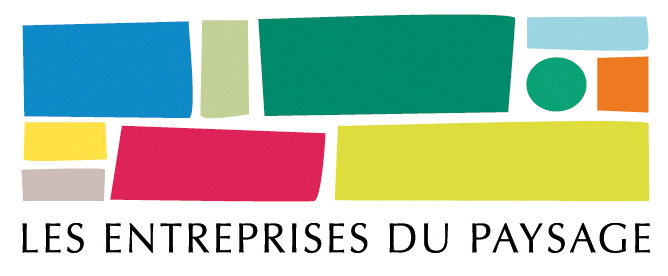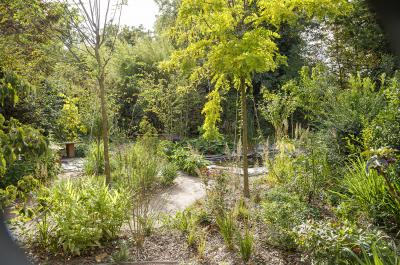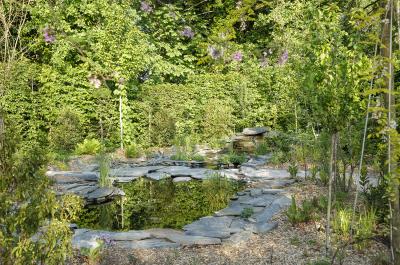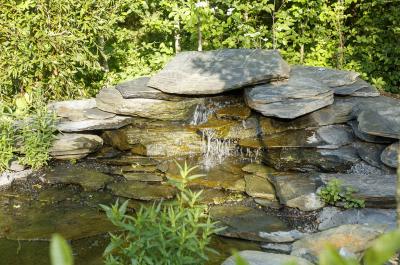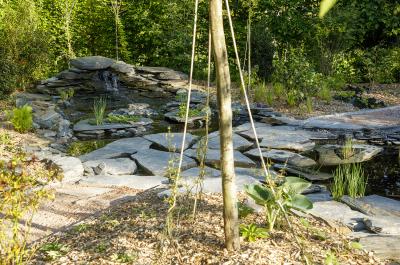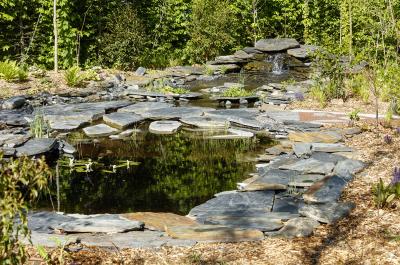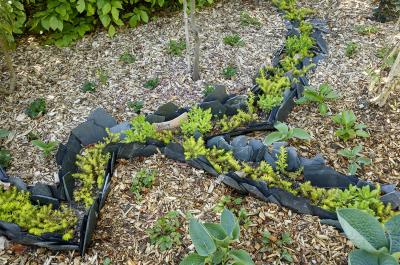17. Jardin Kintsugi
Pansons (pensons ?) nos blessures
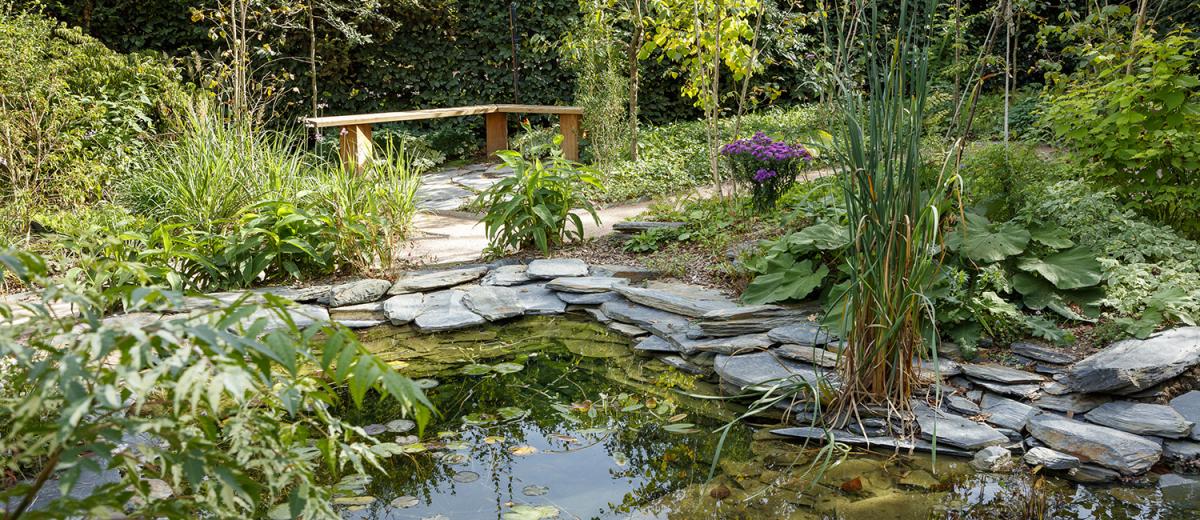
At a time of increasingly worrying climate disruptions, every region in the world is suffering from serious imbalances. Moderation – in relation to energy, the economy, food and technology alike – is upheld during high-level summits. More than ever, the question arises as to whether the living world (animal and vegetable alike) has the ability to recover and prosper after some disaster, whether natural (earthquake, flood, hurricane, and so on) or manmade (soil sealing, mass pollution, nuclear accident, etc.). In an ever more fragile world where humankind must learn from its mistakes, the art of kintsugi takes on its full meaning. This age-old Japanese art consists of mending a broken object but emphasising its scars with gold powder. It shows that, over time and with a little determination, a wound may be healed: it leaves the mark while beautifying it.
This garden bears witness to an earlier traumatic event, apparent from its limestone scars. Its wounds, flaws gilded by yellow sedums, divide the area up. An interplay of viewpoints, perspectives, transparency and topography guides the visitor between the massifs and a watercourse. A place of renewal and balance, this garden is restrained, aesthetic and nourishing all in one. Plant life has succeeded in repairing the wounded earth.
DESIGNERS
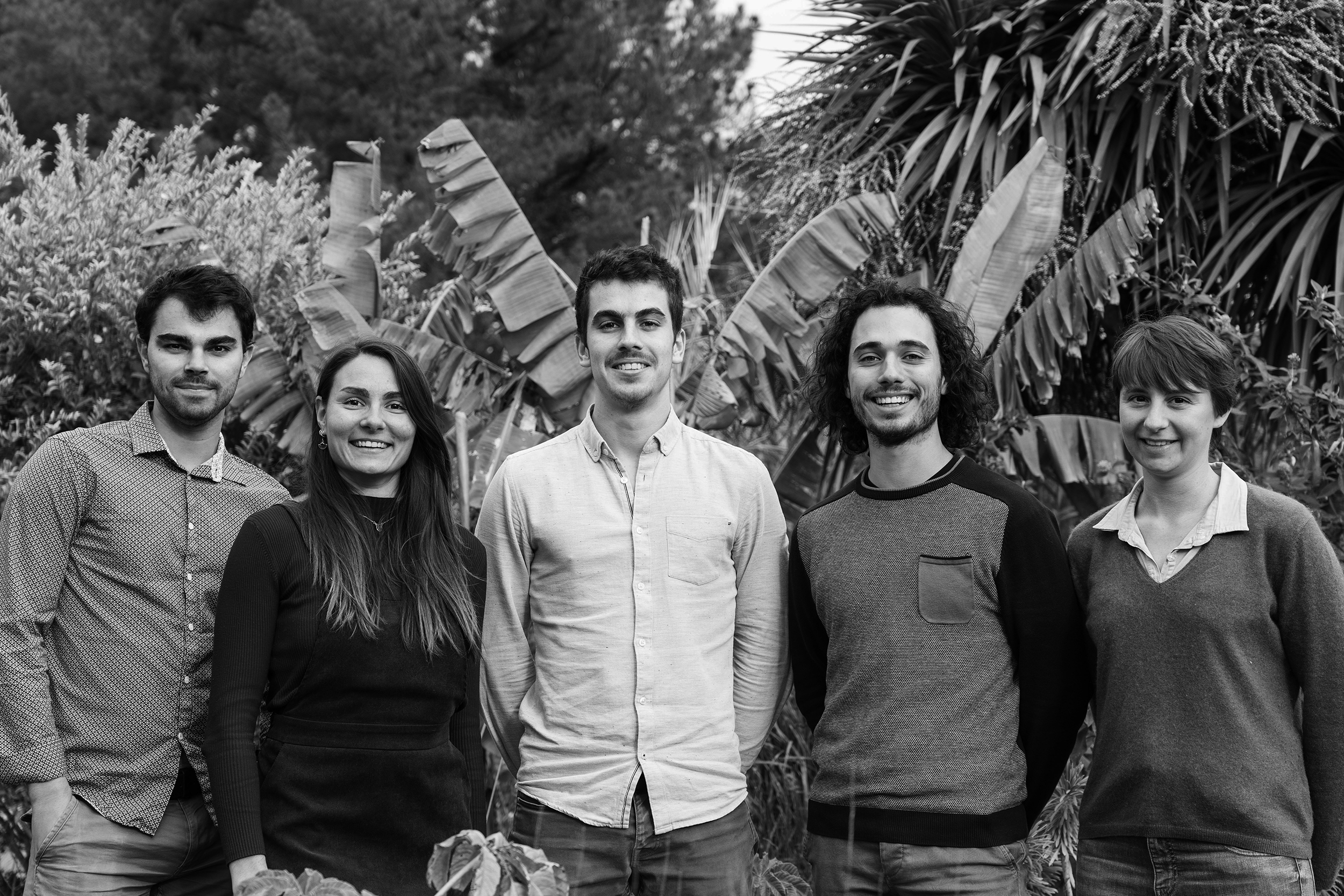
Born in a little village in the heart of the Marais Poitevin Nature Park and the grandson of farmers, Pierre-Henri Blandineau Richard has always lived in close contact with nature. His grandfather taught him to love the earth and his grandmother passed on her interest in flowers. This particular passion manifested itself very early on, as he didn’t take much part in other children’s games, focusing instead on the tools he used to tend his vegetable garden, such as his first cultivator, which he was given when he was just 10 years old. He took part in creation of a vegetable garden at his lower secondary school and carried out placements with landscaping companies in his 3rd year there. When he started his upper secondary education, he opted for a scientific path with the aim of pursuing post-secondary studies in line with his passion. 2 years after passing his baccalaureate in 2017, he obtained an Advanced Technician’s Certificate (BTS) in Landscaping, during which he was selected to design the La Rochelle Prefecture’s garden and also took part in the national plant recognition competition. He is always searching out little-known plants in order to grow them in his grandparents’ former lands, which he is gradually taking over and cultivates in parallel to provide fodder for his mare, which he rides competitively. This has led him to continue his studies, taking a competitive entrance exam to the Institut Agro Angers (the former Institut National d’Horticulture), and entering its horticulture stream. For his final year, he has chosen to include an option developing horticultural products and productions, and should be graduating in 2023. His engineering degree will enable him to pursue a career in ornamental horticulture. In the longer term, once he has acquired enough experience, he hopes to communicate what he has learnt and his love of flowers through teaching.
Sarah Brégeon was born in Haute-Marne but only stayed there for five years, growing up in Isère, in the Grésivaudan Valley. There, surrounded by mountain massifs, she acquainted herself with its landscapes, plant life and climate, and the challenges involved in this very special environment. Then came another move, this time to Charente-Maritime, and studies that gave her the opportunity to get to know other regions over the course of a few months or several years. Plant life always accompanied her wherever she was, whether in the garden, the forest, farmlands, grasslands or the many other places she found herself in. Her relocations didn’t stop her from returning to where she had once lived. Her childhood holidays spent enjoying herself in her grandparents’ garden in Meuse and her friends who still lived in Isère enabled her to maintain old ties and observe the changes that have come about over time, whether through development or management or due to climate change. It was in this context that she was gradually drawn to the plant kingdom and more specifically to landscape. The changes in environments that she had observed made her want to work on the systemic notions that affected living things of all kinds. Helping local authorities tackle the issues involved in territorial biodiversity, naturalness and habitability through landscape is her goal for the future. To achieve it, she can count on her Advanced Agricultural Technician Certificate (BTSA) in Agronomy and Plant Production and, more recently, her course in landscape engineering at Institut Agro Angers (the former Institut National d’Horticulture), which she should graduate from in 2023.
Loïse Guiberteau is currently a landscape engineering student in her final year at Institut Agro Angers. After obtaining her scientific baccalaureate, she decided to study medicine. But by the end of her first year, she realised that this particular path was not really for her. After a good deal of thought, she hit on the two things she was really interested in: drawing and plant life, both of which had meant so much to her in her childhood. She had always shown a talent for drawing and, fascinated by the beauty of the landscapes around her, had tried to depict them on paper. Her curiosity about plants and interest in gardens had been transmitted to her by her father, a great nature lover. As a small and somewhat reckless child, she had no hesitation in climbing trees and playing in her wooden treehouse. Driven by this pronounced taste for nature, she naturally decided to take an Advanced Technician’s Certificate (BTS) in Landscaping (an online course delivered by Angers ESA), and continued with her engineering studies. Mindful of ecological concerns and keen to improve quality of life, her aim is to design greenspaces with the main goal of creating places that participate in their users’ wellbeing. In a world where lifestyles generate stress and uncertainty; and in the face of a changing society, she ponders the best ways of curing these ills via the design of gardens providing peace, rest and relaxation and so enabling their users to recharge their batteries. With her wide botanical knowledge and creativity to back her up, she wants to put her landscaping skills at the heart of her reflections in order to contribute to the improvement of the environment’s health status.
Ewen Le Thomas was born in Compiègne in the north of France. His family soon moved to Guidel, by the sea in Brittany, where his parents still live. Brittany is a region able to provide countless different landscapes in the space of a short walk, and so it was natural enough that he grew up between land and sea. This is where he played and explored, playgrounds that later became his sportsgrounds. Today, the changes that have come about there, including urbanisation of the seafront, have made him aware of the issues facing these areas and their fragility. It is an interest that also came from his parents and his education. 10 years ago now, they purchased a 7,000-m² piece of land and had their house built on it. They didn’t transform the land completely. Part of it became the garden, and the rest still belongs to the forest and its occupants. Creation of the garden, restoration and maintenance were formative activities rewarded by the appearance of wild animals near the house and gradual development of plant life. It was a setting that was its own education system, creating respect for the living beings that surround us. It was also a place in which he could express his own creativity, through drawing, woodwork, model making and painting figurines. After taking his scientific baccalaureate, he decided to enrol at Agrocampus Ouest (now Institut Agro Rennes-Angers). His time there helped him understand what the word landscape really meant and decided him to make it his career. Now that his final year as a student has come to an end, he also wants to innovate, focusing on habitation, garden and the ability to merge them together to create a single landscaping feature.
A native of Mayenne, the son of two parents who teach at vocational schools, grandson of farmer grandparents, and youngest of 3 children, Armand Pinot grew up in a village of 550 inhabitants, a truly rural environment where manual activities became one of his favourite pastimes at a very early age. He has always loved meeting challenges, whether great or small. For example, he mentions his participation in the 2020 4L Trophy rally along with his best friend, when, in just a few months, they managed to raise a budget of €9,000, buy a car and get it ready, make funding sales, find equipment and financial partners, and so on. Working in the field of landscape was also one of his personal goals. It was a field that had been of interest to him ever since he started lower secondary school and he carried out all his school placements involved in it. After passing a technological baccalaureate at an agricultural school, he went on to take an Advanced Technician’s Certificate (BTS) in Landscaping, which taught him a great deal about landscaping techniques. He then enrolled at Agrocampus Ouest (now Institut Agro) in Angers to prepare a degree in landscape engineering, in a work-study programme that included an apprenticeship in a landscape design and creation company. His next goal is to obtain his degree and then design and create landscaped gardens for private customers.
